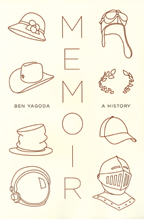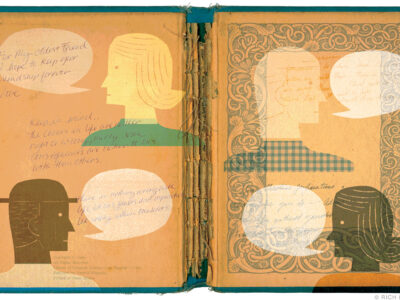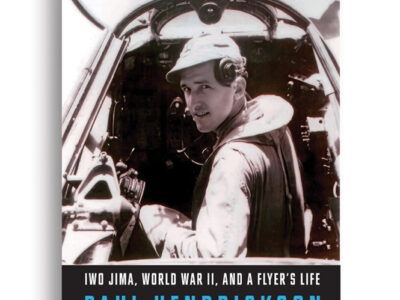A new book explores the well-populated landscape of Memoir.

The urge to tell the story of one’s own life is surely among the most powerful human desires. Memoirs (and their identical twins, autobiographies) have been with us for almost as long as there have been audiences large and literate enough to justify the effort of writing them.
In Memoir: A History (Riverhead Books, 2009), Ben Yagoda G’91 examines this venerable genre, from the commentaries and confessions of Julius Caesar and St. Augustine through Jean-Jacques Rousseau and Benjamin Franklin and up to the recent best-selling works of Frank McCourt and Mary Karr and James Frey. (As Yagoda’s book makes clear, there is nothing new about the fabrications of Frey and certain other contemporary self-chroniclers.)
Senior editor Samuel Hughes recently spoke with Yagoda about Memoir and memoirs. That the subject matter is vast to the point of daunting can be gleaned from Yagoda’s response to a tweak about the omission of Giacomo Casanova’s monumental History of My Life. “My decisions about what to include,” he said, “were based on a sort of triage: 99-plus percent of all memoirs didn’t get a mention, so there was a lot of heated competition for real estate.”
Why did you decide to write this book?
To paraphrase George Mallory, because it was there. That is, there did not exist a good, recent history of memoir and autobiography—kind of amazing, considering how rich that history is and how important the form is in current literature.
You write that “the memoir boom, for all its sins, has been a net plus for the cause of writing.” Is that because, as William Dean Howells wrote in 1909, memoirs constitute “the most democratic province of the republic of letters?”
That was not actually what I had in mind, though now that you point it out, it’s true that memoirs have led the way in promulgating the worthwhile idea that you do not need to be from a certain social class, or have a certain amount of money, or even to have reached a certain level of achievement to be “qualified” to write a book. Having a good story and the skill to tell it well is enough.
What I was referring to in the book is my sense that the average memoir is better than the average novel. Don’t get me wrong: I believe that it is an extraordinary achievement to write a great novel, and I also believe that even now, there are more great novelists than great memoirists. But there are also more bad novelists than bad memoirists. It’s not for no reason that the biggest cliché in the writing-teaching business is: write about what you know. Intimate knowledge of the subject matter produces strong, authoritative writing. And memoirists, for all their sins and occasional self-indulgence, certainly know their subject matter.
Any big surprises as you were doing your research?
I was constantly surprised! The biggest challenge in doing the book was to corral the tens of thousands of memoirs that have been written into a readable narrative, and one of my main principles was to include the ones whose authors, content, and back-story I didn’t know about. So, for example, I have several pages on Edmund Gosse’s Father and Son, a wonderful and almost completely forgotten 1907 book that I argue is the progenitor of the modern memoir.
I was also taken aback by a large subgenre whose existence I wasn’t aware of, and which gets no attention today. From roughly the late 1920s till the mid-1960s, virtually every American autobiography by a “normal” person (as opposed to politicians, movie stars, athletes, and other celebrities) was a humorous, nostalgic, or warm-hearted account—and sometimes all three. This includes books like The Egg and I, by Betty MacDonald; See Here, Private Hargrove, by Marion Hargrove; Please Don’t Eat the Daisies, by Jean Kerr; and hundreds more, now long forgotten. This, of course, is in marked contrast to the memoir of today—see Frank McCourt’s Angela’s Ashes and Jeanette Walls’ The Glass Castle—which focuses on trauma and is generally unhappy.
What memoirs have you most admired, and why?
So many! Among recent books, Angela’s Ashes, The Glass Castle, J.R. Moehringer’s The Tender Bar, Tobias Wolff’s This Boy’s Life, and Mary Karr’s The Liars’ Club are all outstanding. Each is about difficult times in childhood, but each emphasizes the particularity of that childhood, and recounts it with great insight, perceptiveness, humor, humility, and storytelling skill.
I also have to give a shout-out to two books that left me depressed: Alec Guinness’s Blessings in Disguise and Bob Dylan’s Chronicles, Part I. Both authors known for something other than writing, but they’re better writers than I, a so-called professional.
Among memoirs of the past, you cannot discuss the form without mentioning Rousseau’s Confessions, written more than 200 years ago but still completely fresh, especially in its insistence on absolute honesty.
What makes a great memoir? Is it the artistry and narrative voice of the author or the uniqueness and drama of the life?
Well, both, but I would say artistry and narrative take precedence. After all, if you think about books like The Tender Bar or Ruth Reichl’s similarly titled Tender at the Bone, not much really happens in either one. Basically, a young person encounters some obstacles and eventually becomes an adult. But they are better books than you’d get from a dim bulb writing about being raised by wolves.
I came away from your book thinking that memoir, more than any other literary genre, reflects the “invisible hand of the marketplace.” If a nonfiction memoir isn’t titillating or entertaining enough to interest a publisher, the author can make it more marketable by juicing it up with “better” (made-up) memories. Or, as in the case of James Frey and his A Million Little Pieces, he can change the genre from fiction to memoir.
You’re right, but those juicing authors, just like juiced-up ballplayers, are playing a dangerous game. That is to say, the appeal of a memoir is based to a great extent on readers’ sense that it is true. If an author is shown to have fabricated or grossly exaggerated (as Frey did), his or her credibility and career are in a very bad way.
You note that “the late 1920s were the golden age of autobiographical hoaxes,” and that the past four decades “will probably be remembered as the golden age of autobiographical fraud.” What’s the difference, and how do you explain both, given that autobiographical deceit has been around for many years?
Well, thank you for thinking I was making an important distinction, and not just guilty of repetitive phrasing! Actually, there was a difference. Bogus autobiographies of the 1920s, most notably Joan Lowell’s Cradle of the Deepand Alfred Aloysius Smith’s Trader Horn, had a sort of winking quality to them: People didn’t really, really think they were one hundred percent true. By contrast, recent books, from Clifford Irving’s fake autobiography of Howard Hughes, through Forrest Carter’s fake Education of Little Tree, through James Frey’s fake memoir, all the way up to Margaret Jones’s Love and Consequences, leave a bad taste in your mouth. They are the result of some unpleasant combination of fraud and self-delusion.
You say that if Life with Father author Clarence Day wrote a memoir today, “it would in all likelihood center on his battle with arthritis.” What does that say about us as a society then and now?
At the risk of being obvious, it says: in those days we did not feel that personal ailments and travails were appropriate subjects for public consumption, while today, not only do we think they are appropriate, we are fascinated by them.




